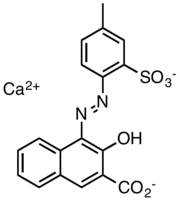Lake pigment
A lake pigment is a pigment manufactured by precipitating a dye with an inert binder, or "mordant", usually a metallic salt. Unlike vermilion, ultramarine, and other pigments made from ground minerals, lake pigments are organic.[1] Manufacturers and suppliers to artists and industry frequently omit the lake designation in the name. Many lake pigments are fugitive because the dyes involved are unstable when exposed to light. Red lake were particularly important in Renaissance and Baroque paintings; they were often used as translucent glazes to portray the colors of rich fabrics and draperies.[2]
Etymology
This sense of lake is unconnected with lake meaning body of water; it derives from the word lac (referring to a resinous secretion).[3] It has the same root as the word lacquer, and comes originally from the Hindi word lakh, through the Arabic word lakk and the Persian word lak.[4]
Chemistry
Many lake pigments are azo dyes. They characteristically have sulfonate and sometimes carboxylate substituents, which confer negative charge to the chromophore (colored species).
The metallic salt or binder used must be inert and insoluble in the vehicle, and it must be colourless or very neutral.[1] The organic component of the dye determines which wavelengths are absorbed and reflected by the resulting precipitate. In ancient times chalk, white clay, and crushed bones were used as sources of the calcium salts. The salts that are commonly used today include barium sulfate, calcium sulfate, aluminium hydroxide, and aluminium oxide (alumina), all of which can be produced cheaply from inexpensive mineral ores.
 A typical lake pigment is Lithol Rubine BK.
A typical lake pigment is Lithol Rubine BK.
History and Art
-
_-_WGA22811.jpg)
Titian used glazes of red lake to create the vivid crimson of the robes in "The Vendramin Family Venerating a Relic of the True Cross", completed 1550-60 (detail).
Lake pigments have a long history in decoration and the arts. Some have been produced for thousands of years and traded over long distances.
The red lakes were particularly important in the history of art; because they were translucent, they were often used in layers of glazes over a more opaque red (sometimes the mineral-based pigment vermilion, or sometimes a red lake mixed with lead white or verilion) to create a deep, rich red color. They were very often used by Titian and other Venetian artists of the 15th century to depict fine draperies and fabrics.[2]
- Indigo lake was originally produced from the leaves of woad, and was known in ancient Egypt. In the late Middle Ages, a fashion for woad as a textile dye led to overplanting and soil exhaustion in many parts of Europe. After trade routes opened to the east, indigo was imported from India as a substitute for woad, and the cultivation of woad became uneconomical in Europe. Today, the dark blue dye known as indigo once produced from woad and Indigofera tinctoria is largely of synthetic origin. The dye and pigment are both fugitive.[5]
- Rose madder lake, originally from the root of the madder plant, is also known as alizarin crimson in its synthetic form. Since rose madder is fugitive when exposed to light, its use has been largely superseded, even in synthetic form, by quinacridone pigments.
- Carmine lake was originally produced from the cochineal insect, native to Central and South America. It is also called crimson lake. When the Spanish conquered the Aztec Empire (1518-1521), they encountered Aztec warriors garbed in an unknown crimson color. Cochineal became their second most valuable export from the New World, after silver, and the Spanish zealously guarded the secret of its production for centuries.[6] Carminic acid, the organic compound which gives carmine its color, was synthesized in 1991.[7]
Indigo and rose madder are now produced more cheaply from synthetic sources, although some use of natural products persists, especially among artisans. The food and cosmetics industries have shown renewed interest in cochineal as a source of natural red dye.
Notes
- 1 2 K. Hunger. W. Herbst "Pigments, Organic" in Ullmann's Encyclopedia of Industrial Chemistry, Wiley-VCH, Weinheim, 2012. doi:10.1002/14356007.a20_371
- 1 2 David Bomford and Ashok Roy, A Closer Look - Colour, National Gallery Company, p. 41.
- ↑ "lake, n.6". OED Online. December 2011. Oxford University Press. 25 January 2012.
- ↑ Webster's New World Dictionary of American English, Third College Edition, 1988.
- ↑ Society of Dyers and Colourists (1999). "A Colour Chemist's History of Western Art". Review of Progress in Coloration 29 (Millennium Issue): 43–64.
- ↑ Amy Butler Greenfield (2005). A Perfect Red: Empire, Espionage, and the Quest for the Color of Desire. HarperCollins. ISBN 0-06-052275-5.
- ↑ Allevi, P.; et al. (1991). "The 1st Total Synthesis of Carminic Acid". Journal of the Chemical Society-Chemical Communications 18: 1319–1320.